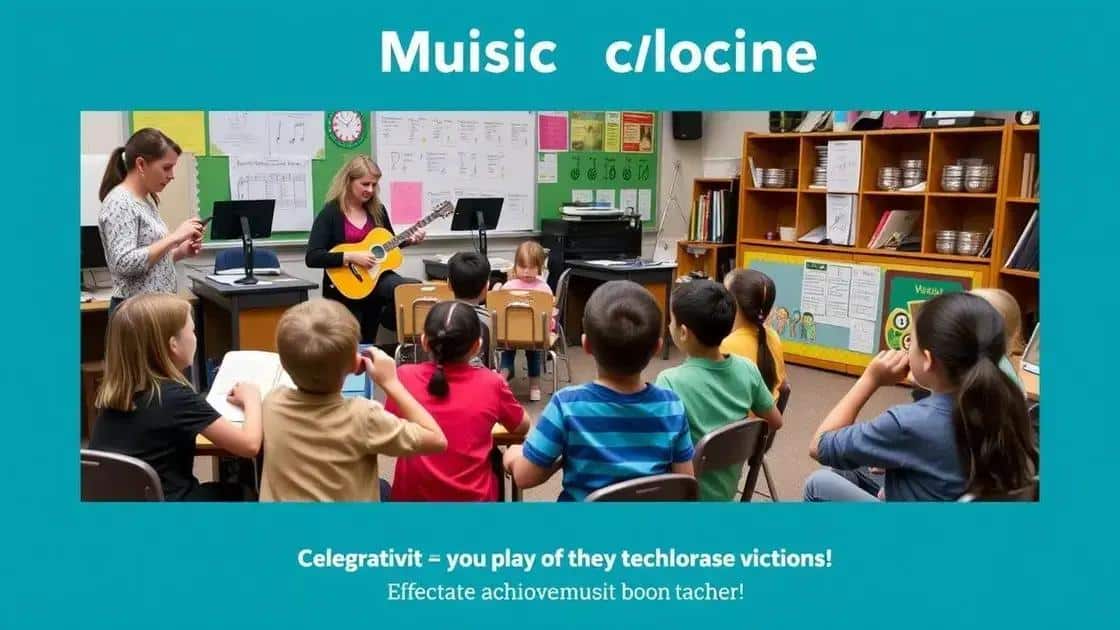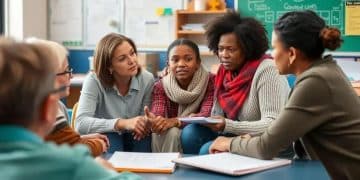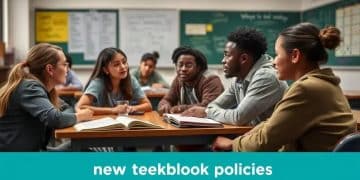Music learning disability support: enhancing accessible education

Music learning disability support involves tailored teaching strategies, resources, and a positive environment to help students overcome challenges and thrive in their musical education.
Music learning disability support plays a crucial role in ensuring that all students can thrive in their musical journey. Have you ever wondered how tailored approaches can empower learners facing challenges? This article investigates strategies that can make a difference.
Understanding music learning disabilities
Understanding music learning disabilities is essential for recognizing the unique challenges some learners face in musical education. These disabilities can impact various aspects of learning, from reading music to rhythm and pitch recognition. By identifying these challenges early on, educators can provide the necessary support to help students thrive.
Defining Music Learning Disabilities
Music learning disabilities refer to a range of difficulties that affect an individual’s ability to learn music. These can manifest in various forms and may overlap with other learning disabilities. It’s important to clearly define these challenges to understand how to support affected learners effectively.
Common Types of Music Learning Disabilities
- Amusia: Difficulty in recognizing musical pitches, rhythms, or tones.
- Dyslexia: Challenges with reading musical notation, similar to struggles faced in reading text.
- Auditory Processing Disorders: Trouble processing sounds, which can hinder musical learning.
By knowing these common types, educators can be more aware of the signs displayed by students. Support for these students often requires individualized approaches tailored to their unique needs.
Additionally, supportive teaching strategies can significantly impact how students engage with music. Understanding that each learner requires a different level of support can foster a more inclusive environment. For instance, using visual aids can help students who struggle with auditory processing.
Identifying Signs of Music Learning Disabilities
Recognizing the signs of music learning disabilities early on is crucial. Educators should watch for indicators that a student might be struggling. These may include:
- Difficulty keeping beat or rhythm.
- Inconsistent pitch matching.
- Frequent confusion with musical symbols.
By identifying these signs, teachers can take a proactive approach in offering the necessary support and adjustments to their teaching methods. It is essential to collaborate with parents and specialists to create an effective learning plan.
In summary, understanding music learning disabilities leads to better educational practices and more supportive environments. By being aware of the signs and types of these disabilities, we can work towards an inclusive approach in music education.
Identifying signs of music learning challenges
Identifying signs of music learning challenges is an important step in supporting students who may struggle with music education. Early detection can lead to effective strategies that foster musical growth and enjoyment. Teachers and parents should work together to observe specific behaviors that may indicate difficulties in learning music.
Common Signs to Look For
Many students may exhibit various signs that suggest they are having trouble with music concepts. It’s essential to recognize these early on. Some common indicators include:
- Struggling to keep time with a beat during practice or performance.
- Frequent errors in pitch accuracy when singing or playing instruments.
- Difficulty in remembering musical notes or symbols.
These signs can greatly vary from one student to another, as each individual learns differently. Therefore, being attentive to each child’s unique needs is crucial. For instance, a student may excel in playing an instrument yet face challenges in reading music.
Behavioral Indicators
Alongside musical signs, behavior can also provide clues. Students showing a lack of interest in music activities or becoming easily frustrated during lessons may need additional support. Observing how a student interacts with music can offer insights into their specific learning challenges.
Sometimes, anxiety about performing in front of others can also hinder a student’s willingness to engage in music lessons. Open communication with students about their feelings can help educators understand and address these emotional barriers.
Encouragement plays a key role in helping students overcome their challenges. Being patient and offering positive reinforcement can boost their confidence and willingness to engage with music. Focusing on the enjoyment of music rather than just accuracy can create a more supportive atmosphere.
Ultimately, understanding and identifying music learning challenges allows educators and parents to create personalized learning plans. By celebrating small victories and recognizing individual progress, students can develop their musical skills more effectively.
Effective teaching strategies for support

Effective teaching strategies for supporting students with music learning disabilities can make a significant difference in their educational experience. By employing specific techniques, educators can help these learners engage more fully with music and develop their abilities.
Differentiated Instruction
One effective approach is differentiated instruction, which tailors teaching methods to meet the diverse needs of students. Educators can assess individual strengths and weaknesses, then adapt lessons accordingly. This might mean providing extra time for certain tasks or using different teaching aids that resonate with each student.
Multi-Sensory Learning
Incorporating multi-sensory learning can help students grasp complex musical concepts. By appealing to various senses, teachers can create engaging lessons that cater to different learning styles. For example, using visual aids like diagrams or colored notes alongside auditory cues can reinforce learning.
- Use visual tools like charts and pictures to clarify musical theory.
- Incorporate tactile activities, such as using rhythm instruments to understand beat.
- Engage students with movement activities related to music.
These strategies help solidify concepts in students’ minds by creating connections across different modalities.
Positive Reinforcement
Utilizing positive reinforcement is another key strategy. Recognizing and celebrating small successes can boost students’ confidence. By providing verbal praise or rewards for progress, educators encourage a growth mindset and foster resilience.
For instance, after a student learns a new song, providing immediate feedback and encouragement for their efforts can deepen their interest in music. This supportive atmosphere allows students to take risks in their learning without fear of failure.
Collaboration and Communication
Encouraging collaboration among students can also enhance learning experiences. Group activities, such as ensemble playing, promote social skills and allow students to learn from each other. Open communication with students about their preferences and challenges ensures ongoing support tailored to their needs.
Ultimately, the goal is to create an inclusive environment where every student feels valued and motivated to expand their musical abilities. By implementing these effective teaching strategies, educators can significantly impact the musical journeys of learners facing challenges.
Resources and tools for educators
Resources and tools for educators play a vital role in enhancing music education for students, especially those with music learning disabilities. Utilizing the right materials can significantly impact a student’s ability to learn and enjoy music.
Educational Software and Apps
Many software programs and applications are designed specifically for music education. These resources provide interactive ways for students to engage with music theory and practice. Some popular options include:
- Noteflight: An online music notation application that allows students to compose, share, and play back their music.
- Yousician: An app that offers guided lessons for various instruments and is suitable for different skill levels.
- SmartMusic: An interactive music practice tool that provides feedback on performance.
These digital tools can accommodate different learning speeds and styles, making music more accessible.
Visual Aids and Manipulatives
Using visual aids is another effective method. Charts, flashcards, and color-coded music notes can help students with music learning disabilities understand concepts more easily. For example, using colored stickers on instruments can visually represent different notes or rhythms, making lessons more engaging.
Teachers can also incorporate manipulatives like rhythm blocks or musical instruments to provide hands-on learning experiences. This type of learning can help students grasp musical concepts through tactile engagement.
Professional Development for Educators
Continuous education for teachers is essential. Workshops and training sessions focusing on music learning disabilities can improve educators’ skills in identifying and supporting these students. Resources such as webinars, online courses, and local classes offer valuable insights into effective teaching strategies.
Networking with other music educators can also provide new ideas and collaborative opportunities. Joining professional organizations focused on music education can offer access to valuable resources and support groups.
Incorporating these resources and tools helps create a more inclusive and engaging music learning environment. By equipping themselves with the right materials, educators can make a lasting impact on their students’ musical journeys.
Fostering a supportive learning environment
Fostering a supportive learning environment is essential for students with music learning disabilities. Creating a safe space where students feel valued and understood encourages them to express themselves musically. Every student deserves the chance to thrive, especially those facing unique challenges in music education.
Creating a Welcoming Atmosphere
One of the first steps in fostering a supportive environment is to make the classroom welcoming. This can include using positive language, displaying students’ work, and encouraging collaboration. When students feel at home in their classroom, they are more likely to participate actively.
Building relationships with students is crucial. Educators should take time to learn about each student’s interests and challenges. This approach not only helps teachers tailor their instruction but also demonstrates to students that they are cared for and respected.
Encouragement and Positive Feedback
Providing consistent encouragement is vital. Positive feedback helps reinforce students’ efforts and achievements, no matter how small. By recognizing their progress, educators foster motivation. For example, celebrating a student’s improved rhythm, even if it’s just a small step, can significantly boost their confidence and engagement.
- Use praise frequently to acknowledge hard work.
- Set achievable goals to help students experience success.
- Encourage peer support and collaboration to build community.
Peer support can also play a significant role. Encouraging students to work together provides opportunities for shared learning experiences, which can enhance their musical understanding.
Diverse Teaching Strategies
Employing a variety of teaching strategies is crucial in meeting students’ diverse needs. Incorporating different learning modalities, such as kinesthetic activities, visual aids, and auditory tasks, ensures that all students can engage with the material. This method reinforces the idea that everyone can participate in music at their own level.
Adapting lessons to include hands-on activities, such as using instruments or movement, can create a more dynamic and engaging classroom experience. Such strategies cater to the various learning styles present in a diverse classroom, ensuring that every student has the opportunity to learn effectively.
By focusing on fostering a supportive learning environment, educators can help students with music learning disabilities not only improve their skills but also develop a lifelong passion for music. A nurturing atmosphere encourages exploration and resilience, allowing all students to embrace their musical journeys with confidence.
The journey to support students with **music learning disabilities** involves creating a nurturing and engaging learning environment. By utilizing effective teaching strategies, providing the right resources, and fostering positive relationships, educators can significantly impact their students’ musical experiences. It is essential to cultivate a classroom atmosphere that encourages exploration and growth. Every student deserves the opportunity to discover their love for music and develop their talents. Together, we can build inclusive music education that allows all learners to shine.
FAQ – Frequently Asked Questions about Music Learning Disabilities Support
What are music learning disabilities?
Music learning disabilities refer to difficulties some students face in understanding musical concepts, which can affect their ability to read music, play instruments, or recognize rhythms.
How can teachers support students with music learning disabilities?
Teachers can support these students by using differentiated instruction, incorporating multi-sensory learning, and providing a supportive and encouraging classroom environment.
What resources are available for educators?
There are various resources, including educational software, visual aids, and professional development opportunities focused on teaching strategies for music learning disabilities.
Why is a supportive learning environment important?
A supportive learning environment is crucial as it helps students feel safe and valued, encouraging them to express themselves and engage more fully with music.






